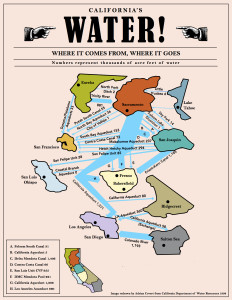 (Image: ‘Atmospheric Rivers Painting,’ acrylic on canvas, by Jan Routh, and found here.)
(Image: ‘Atmospheric Rivers Painting,’ acrylic on canvas, by Jan Routh, and found here.)
Sprinkling rain and chilly this near-noon Wednesday here in California’s Central Valley — for the first time in a great while, Leroy and I couldn’t take our morning walk, as it’s just too cold to venture out, even into a sparsely-wet environment.
Just nature’s way the next couple of weeks.
Although, the approaching storms have been termed ‘atmospheric rivers,’ however, supposedly these incoming cloudbursts won’t be as heavy, and destructive, as those in January — that sucked. We’re forecast for just drizzle and showers today with the heavy shit coming tomorrow night and lasting through Saturday. Another AR is slated for Monday.
Maybe a preview with less meteorological drama via The San Francisco Chronicle this morning,:
To Jan Null, a climate consultant and adjunct professor of meteorology and climate sciences at San Jose State, even naming such a storm is overkill.
“Prefacing everything with the term ‘atmospheric river’ is over-hyping it,” Null said.While parts of the North Bay and Santa Cruz Mountains will see some serious rainfall, this won’t be the catastrophic California storm some have chalked it up to be. And lots of uncertainty remains on whether this rain will kick off a series of storms synonymous to what Californians experienced beginning December 31, when some nine rain-making systems dumped on the state.
Null broke the coming weather into two fronts, the first system coming Thursday and a weaker one coming Monday. Combined they amount to “good moderate winter storms that will be warmer than recent storms but not to the point where you will see a massive amount of snowmelt.”
The ferocity of the next round of winter storms is still up for discussion. That’s largely because of the large amount of analysis that needs to be done before meteorologists can confidently say when and where storms will make landfall and how strong their impacts will be.
[…]
The high-pressure system off the California coast showed signs of weakening last week, prompting a look into how neighboring low-pressure systems would react. A few models signaled that the collapse of the high-pressure system would lead to more low-pressure systems nearing the West Coast. Some even signaled that these systems would tap into a river of atmospheric moisture, aka the Pineapple Express.
This past weekend, weather models started to align – meaning there was more agreement in the chances for the storm to form, but there was still disagreement over the intensity of rain, wind and snow potential. The resolution began to increase by Tuesday, providing a clearer picture of the potential impacts from this warm, moisture-rich storm — including the risk for melting snow at various elevations of the Sierra Nevada.
For now, what is certain is that this upcoming storm will feature strong winds and rain out of the southwest on Thursday afternoon and into Friday morning. This includes the risk for heavy downpours causing urban flooding and river flooding in rural areas.
“Our greatest concern is flooding and the winds that will bring down trees and lines and create power outages,” said Roger Gaff, meteorologist with National Weather Service Bay Area. “The next concern is localized street flooding and overflowing creeks. The overall impact will be significant.’’
And some good news for tired-as-shit-of-rain person: ‘On top of that, the signal for those atmospheric conditions to develop just isn’t as apparent as what was showing up in December and January. The levels of moisture and the positions of these storms could still change, but the alarm bells aren’t ringing in professional meteorological spaces who forecast the long-range outlook for California.‘
Yet it’s going to get heavy-duty wet, though:
We can do trajectory analysis to identify air sources in an #atmosphericriver. This analysis is trajectories (SWtoNE) b/w 4AM Tue & Fri *ending* in AR ~1.5 kmAGL. This is also a tropical moisture export or #pineappleexpress AR. #CAwx Tropical source -> higher freezing levels pic.twitter.com/Og2IDXFsQW
— CW3E Scripps (@CW3E_Scripps) March 8, 2023
And some expert details from noted climate scientist Daniel Swain, with a West Coast emphasis:
New Weather West post on the upcoming strong and warm "Pineapple Express"-type #AtmosphericRiver storm inbound into NorCal–including what to expect (and what NOT to expect). This will be different than the Dec-Jan storm sequence. #CAwx #CAwater https://t.co/W0TH8WIZTC
— Daniel Swain (@Weather_West) March 8, 2023
Swain’s take yesterday at his own Weather West site (now 33, he developed WW while still a student at San Rafael High School):
It’s been all over the news, and I’m here to tell you this much is true: a moderate to strong atmospheric river, with origins in the subtropics near Hawaii (hence, a “Pineapple Express” type event), is headed for California. ETA: late Thursday along the NorCal coast, and Friday further inland. This event will most likely be a “strong” (but not “extreme” or “exceptional”) event–comparable in magnitude (from an integrated water vapor transport perspective) with multiple events that occurred back in Dec and Jan in California.
But in this instance, I think the impacts will likely be quite different than during the remarkable Dec-Jan storm sequence. First of all: this will be a warm and wet storm, with snow levels rising potentially above 6-7k feet (locally 8k+ at the storm’s warmest point). That’s going to result in a lot of snowmelt with the unusually substantial snowpack below ~4,000 feet or so (discussed more below). There will also be widespread moderate to heavy rain across much of NorCal and parts of central CA, leading to moderate rises on larger rivers and perhaps sharper rises on smaller rivers and streams. Some (minor to moderate) flooding is possible on various NorCal rivers this weekend, particularly smaller tributaries of the San Joaquin draining the central/southern Sierra western slope watersheds. Urban/small stream flooding is also likely to be pretty widespread elsewhere across NorCal.
Overall, the precipitation during the upcoming AR (and probably also during any that follow next week) will be more strongly orographic than the Dec-Jan ARs–there could be some pretty strong rain shadowing in lee side locations. This storm probably isn’t going to be quite as dynamic as the Dec/Jan storms, either–the surface low will be weaker and farther away, and the jet stream won’t be in quite as favorable a position. That means that maximum rainfall rates, as well as maximum wind gusts, will likely be lower during this event than previous events this season. So although there will be flooding, and probably some minor wind damage (power outages/limbs down and etc.), this might not be all that remarkable a storm in most of NorCal’s major urban areas (and it won’t be a major storm for SoCal at all).
And we’re facing even longer-term ARs and rain storms:
The Pacific weather setup causing all this chaos is a pretty classic one from a Pineapple Express perspective: a strong ridge of high pressure in the Gulf of Alaska is being “undercut” by a strengthening subtropical jet stream–allowing subtropical moisture from near Hawaii to “phase” with moderately strong but colder low pressure systems diving southward on the east side of the GOA ridge. This puts California squarely in the path of warm ARs that form over the Northeastern Pacific
This overall pattern will probably continue at least into mid-March, although the GOA ridge will eventually weaken and the undercutting will no longer be sustained. That still leaves the storm door open overall, and in particular the risk of subtropical moisture incursions will be elevated. How much flood risk this ultimately produces beyond this weekend remains to be seen: if ARs are mainly weak to moderate and are spaced out widely enough in time, flood concerns would be pretty minor. If said ARs manage to synch up with a stronger surface cyclone, and/or several arrive in quick succsion, then it could very well be off to the races with flood potential given our very large Sierra snowpack. For now, it’s a waiting game; at the moment, I don’t see an obvious severe flood threat in the next 10 days–but the conditional risk will generally be present through April or May given the snow water storage already present.
Even more at the link and from Swain’s whole WW.
And to umbrella us out, The Beatles:
If the rain comes
They run and hide their heads
They might as well be dead
If the rain comes
If the rain comes
No ‘if,’ yet umbrella or not, once again here we are…
 (Illustration out front found here.)
(Illustration out front found here.)